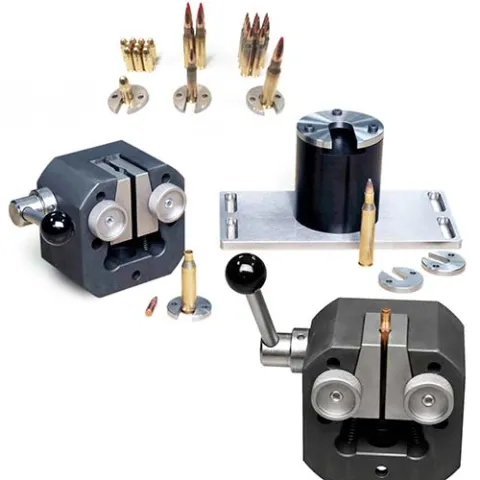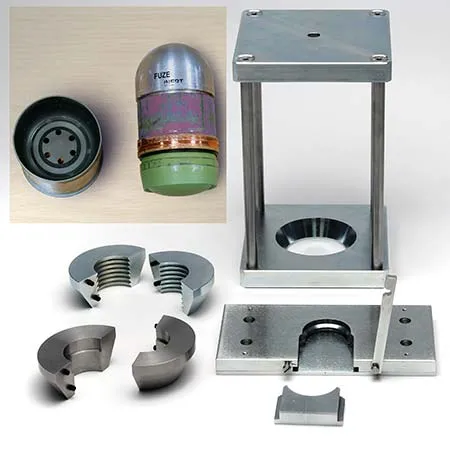Grenade cartridge sheath projectile separation pull testing


Solution
- Software-controlled force testing system
- Dedicated fixtures matched to ammunition size
Benefits
- Flexible programming environment to implement different methods
- Ultimate in repeatable testing with interchangeable accessories
Requirement
When manufacturing ammunition, the projectile is set into the case and it is crimped or sealed in place. The "neck" of the cartridge has natural tension, but the crimp/sealant does the bulk of the work in keeping the projectile in place. It sets the minimum force needed to separate the projectile body from the cartridge case, which is one of the many factors that affect ammunition performance. If the adhesion/friction is inconsistent around the circumference of the ammunition, that variation will often translate into irregular trajectories and impacts for projectiles. Since repeatability is key to effective targeting of ammunition, ballistics engineers work tirelessly to produce reliable ammunition that will perform the same way time and time again
When performing a pull strength test on grenades, it is not possible to grip at the head due to the risk of spillage of powder and the ensuing safety risks. The challenge from the manufacturer was to produce grips which could securely hold the cartridge case and the projectile body below the head when testing forces in excess of 6 kN.
Solution
Mecmesin delivered a pull tester, whose software could clearly identify the 2 expected characteristic force peaks at which the projectile body disengaged from its seating and then passed over a retaining lip as the projectile fully separated from the cartridge case. The test report included how far apart these separation event points were.
Specially developed gripping fixtures held the ammunition firmly in place without slipping as loads up to 6 kN were applied. The base rim of the cartridge case is held in a slotted C-shaped lower fixture—tailored to the calibre of the ammunition—and attached to the base of the pull tester. The projectile body is then secured by two half-round jaws, which locate into a groove on the rotating band. A ‘separation-cage’, connected to the loadcell of the pull tester, driven at a specified fixed rate to ensure optimum repeatability, then lifts the two jaws applying tensile force which is presented graphically within the software.
The test and the maximum force encountered is recorded as the ‘bullet pull strength’ by the software of the tensile tester. The same tester, fitted with an upper compression plate probe is also able to also measure the seating force required to push down on the projectile, until it slips back into the case.
Test equipment
- MultiTest software-controlled pull tester (twin column)
- ILC-T 5000N loadcell
- Dedicated lower fixture and slotted inserts for various calibre specimens
- Upper separation-cage and half-round jaws





















